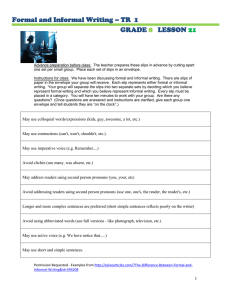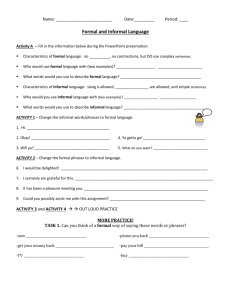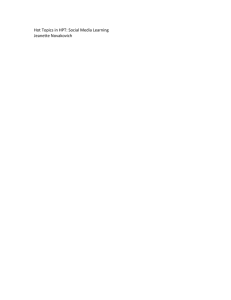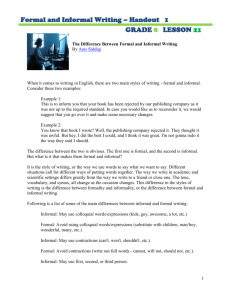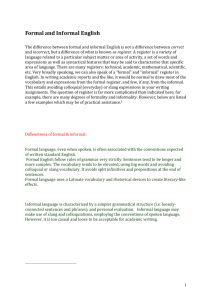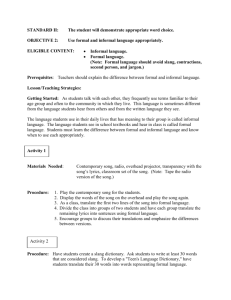Formal vs. Informal Writing: Style Guide & Examples
advertisement
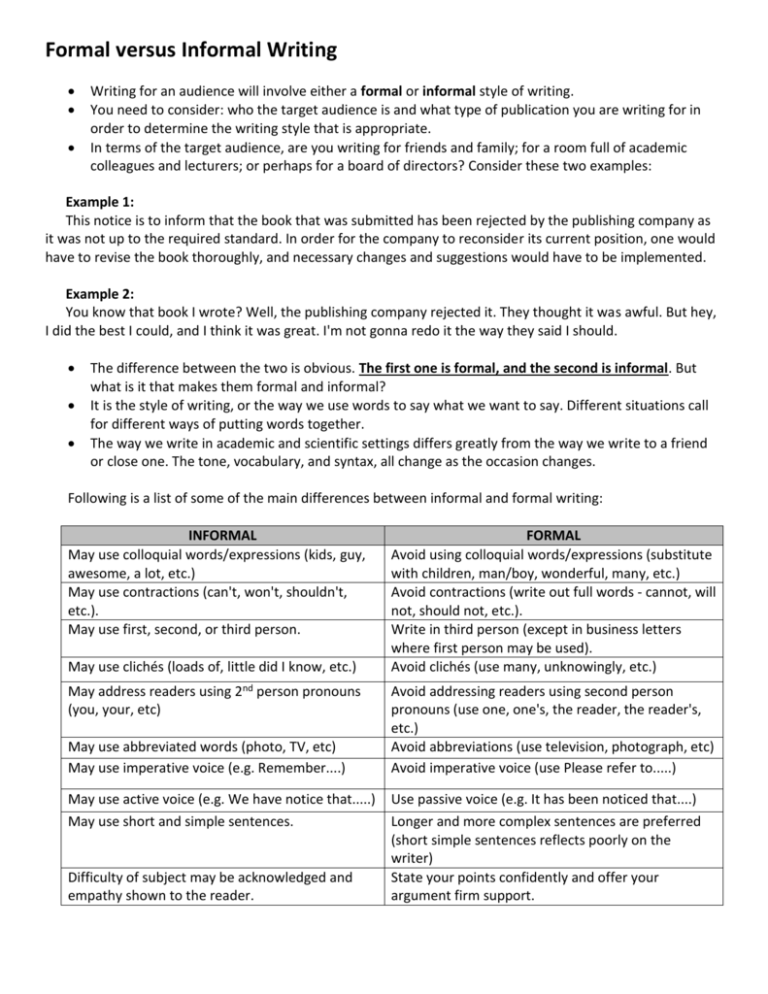
Formal versus Informal Writing Writing for an audience will involve either a formal or informal style of writing. You need to consider: who the target audience is and what type of publication you are writing for in order to determine the writing style that is appropriate. In terms of the target audience, are you writing for friends and family; for a room full of academic colleagues and lecturers; or perhaps for a board of directors? Consider these two examples: Example 1: This notice is to inform that the book that was submitted has been rejected by the publishing company as it was not up to the required standard. In order for the company to reconsider its current position, one would have to revise the book thoroughly, and necessary changes and suggestions would have to be implemented. Example 2: You know that book I wrote? Well, the publishing company rejected it. They thought it was awful. But hey, I did the best I could, and I think it was great. I'm not gonna redo it the way they said I should. The difference between the two is obvious. The first one is formal, and the second is informal. But what is it that makes them formal and informal? It is the style of writing, or the way we use words to say what we want to say. Different situations call for different ways of putting words together. The way we write in academic and scientific settings differs greatly from the way we write to a friend or close one. The tone, vocabulary, and syntax, all change as the occasion changes. Following is a list of some of the main differences between informal and formal writing: INFORMAL May use colloquial words/expressions (kids, guy, awesome, a lot, etc.) May use contractions (can't, won't, shouldn't, etc.). May use first, second, or third person. May use clichés (loads of, little did I know, etc.) May address readers using 2nd person pronouns (you, your, etc) May use abbreviated words (photo, TV, etc) May use imperative voice (e.g. Remember....) May use active voice (e.g. We have notice that.....) May use short and simple sentences. Difficulty of subject may be acknowledged and empathy shown to the reader. FORMAL Avoid using colloquial words/expressions (substitute with children, man/boy, wonderful, many, etc.) Avoid contractions (write out full words - cannot, will not, should not, etc.). Write in third person (except in business letters where first person may be used). Avoid clichés (use many, unknowingly, etc.) Avoid addressing readers using second person pronouns (use one, one's, the reader, the reader's, etc.) Avoid abbreviations (use television, photograph, etc) Avoid imperative voice (use Please refer to.....) Use passive voice (e.g. It has been noticed that....) Longer and more complex sentences are preferred (short simple sentences reflects poorly on the writer) State your points confidently and offer your argument firm support. The main thing to remember is that both are correct, it is just a matter of tone and setting. Formal English is used mainly in academic writing and business communications, whereas Informal English is casual and is appropriate when communicating with friends and other close ones. But whichever style you write in - formal or informal - be sure to keep it consistent, do not mix the two. Why do Students have a Hard Time Understanding Formal Language? Students have a hard time understanding formal language because it is so rare to hear someone say something that is considered “formal.” Nowadays students are so used to writing informally in different settings such as Facebook, Twitter, blogs, texting, casual notes, etc. that it is difficult to switch gears and start speaking and writing informally. Examples of formal language: 1. We request your attendance on the 14th of July. No one talks in this manner any more, but when you read it, you certainly know that formal language is not dead. 2. On speeding tickets, at the bottom, it typically says, that “you are summoned to appear on or before the fourteenth of July 2014 by three o’clock in the afternoon” That would be an example of formal language, and one that teenagers could relate to as they may have been the recipients of speeding tickets. Exercise: On your own try to change the following examples of informal writing to formal writing style. 1. What’s that kid doin’? ______________________________________________________________ 2. That new Eminem song is off the hook. ________________________________________________ 3. How come you don’t mix and chat with other students? ____________________________________ _______________________________________________________________________. Formal Writing Activity List examples of 3 formal writing and 3 examples of informal writing. Be prepared to share your examples with the class INFORMAL EXAMPLES FORMAL EXAMPLES

